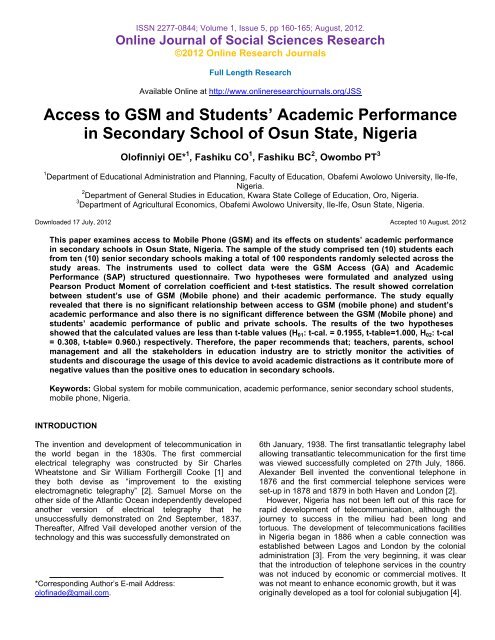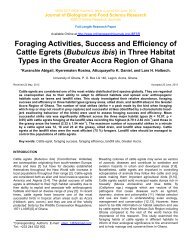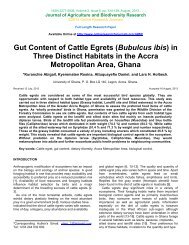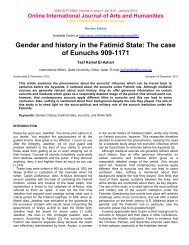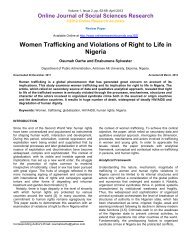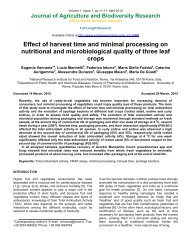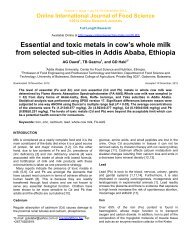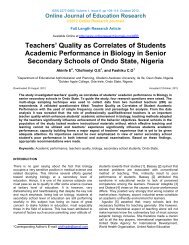Reprint (PDF) - Online Research Journals
Reprint (PDF) - Online Research Journals
Reprint (PDF) - Online Research Journals
Create successful ePaper yourself
Turn your PDF publications into a flip-book with our unique Google optimized e-Paper software.
ISSN 2277-0844; Volume 1, Issue 5, pp 160-165; August, 2012.<br />
<strong>Online</strong> Journal of Social Sciences <strong>Research</strong><br />
©2012 <strong>Online</strong> <strong>Research</strong> <strong>Journals</strong><br />
Full Length <strong>Research</strong><br />
Available <strong>Online</strong> at http://www.onlineresearchjournals.org/JSS<br />
Access to GSM and Students’ Academic Performance<br />
in Secondary School of Osun State, Nigeria<br />
Olofinniyi OE* 1 , Fashiku CO 1 , Fashiku BC 2 , Owombo PT 3<br />
1 Department of Educational Administration and Planning, Faculty of Education, Obafemi Awolowo University, Ile-Ife,<br />
Nigeria.<br />
2 Department of General Studies in Education, Kwara State College of Education, Oro, Nigeria.<br />
3 Department of Agricultural Economics, Obafemi Awolowo University, Ile-Ife, Osun State, Nigeria.<br />
Downloaded 17 July, 2012 Accepted 10 August, 2012<br />
This paper examines access to Mobile Phone (GSM) and its effects on students’ academic performance<br />
in secondary schools in Osun State, Nigeria. The sample of the study comprised ten (10) students each<br />
from ten (10) senior secondary schools making a total of 100 respondents randomly selected across the<br />
study areas. The instruments used to collect data were the GSM Access (GA) and Academic<br />
Performance (SAP) structured questionnaire. Two hypotheses were formulated and analyzed using<br />
Pearson Product Moment of correlation coefficient and t-test statistics. The result showed correlation<br />
between student’s use of GSM (Mobile phone) and their academic performance. The study equally<br />
revealed that there is no significant relationship between access to GSM (mobile phone) and student’s<br />
academic performance and also there is no significant difference between the GSM (Mobile phone) and<br />
students’ academic performance of public and private schools. The results of the two hypotheses<br />
showed that the calculated values are less than t-table values (H01: t-cal. = 0.1955, t-table=1.000, H02: t-cal<br />
= 0.308, t-table= 0.960.) respectively. Therefore, the paper recommends that; teachers, parents, school<br />
management and all the stakeholders in education industry are to strictly monitor the activities of<br />
students and discourage the usage of this device to avoid academic distractions as it contribute more of<br />
negative values than the positive ones to education in secondary schools.<br />
Keywords: Global system for mobile communication, academic performance, senior secondary school students,<br />
mobile phone, Nigeria.<br />
INTRODUCTION<br />
The invention and development of telecommunication in<br />
the world began in the 1830s. The first commercial<br />
electrical telegraphy was constructed by Sir Charles<br />
Wheatstone and Sir William Forthergill Cooke [1] and<br />
they both devise as “improvement to the existing<br />
electromagnetic telegraphy” [2]. Samuel Morse on the<br />
other side of the Atlantic Ocean independently developed<br />
another version of electrical telegraphy that he<br />
unsuccessfully demonstrated on 2nd September, 1837.<br />
Thereafter, Alfred Vail developed another version of the<br />
technology and this was successfully demonstrated on<br />
*Corresponding Author’s E-mail Address:<br />
olofinade@gmail.com.<br />
6th January, 1938. The first transatlantic telegraphy label<br />
allowing transatlantic telecommunication for the first time<br />
was viewed successfully completed on 27th July, 1866.<br />
Alexander Bell invented the conventional telephone in<br />
1876 and the first commercial telephone services were<br />
set-up in 1878 and 1879 in both Haven and London [2].<br />
However, Nigeria has not been left out of this race for<br />
rapid development of telecommunication, although the<br />
journey to success in the milieu had been long and<br />
tortuous. The development of telecommunications facilities<br />
in Nigeria began in 1886 when a cable connection was<br />
established between Lagos and London by the colonial<br />
administration [3]. From the very beginning, it was clear<br />
that the introduction of telephone services in the country<br />
was not induced by economic or commercial motives. It<br />
was not meant to enhance economic growth, but it was<br />
originally developed as a tool for colonial subjugation [4].
For this reason, by 1893, government offices in Lagos<br />
were provided with telephone service, which were later<br />
extended to Ilorin and Jebba in the hinterland. A slow but<br />
steady process of development in the years that followed<br />
led to the gradual formation of the nucleus of national<br />
telecommunication networks [1]. However, as the<br />
European mercantile activities gained foothold in the<br />
country, the first commercial trunk telephone service was<br />
established to link Itu and Calabar in 1923. Between<br />
1946 and 1952, a three channel line carrier system was<br />
commissioned between Lagos and Ibadan and was later<br />
extended to Oshogbo, Kaduna, Kano, Benin and Enugu.<br />
Thus, connecting the colonial office in London with the<br />
commercial centers in Nigeria [1,3]. In those early days,<br />
services were primitive and the coordinated pegboard<br />
switching system was used. This later progressed to<br />
manual switchboards of different sizes, shapes, and<br />
capacities until stronger exchanges were installed into<br />
the national network at Lagos Island, Ikeja, Ebute Meta,<br />
Apapa and Port Harcourt between 1955 and 1960. The<br />
telegraphy service also witnessed a parallel<br />
development, from telegraph delivery by way of manual<br />
coordinated pegboard switching to the use of Morse code<br />
for telex switching. As at 1960, a manual telex exchange<br />
of sixty subscriber lines were in service in Lagos. All the<br />
above efforts were essentially aimed at improving internal<br />
administrative telephone services in Nigeria.<br />
At independence in 1960, with a population of roughly<br />
45 million people, the country only had about 18,724<br />
phone lines for use. This translated to a Tele-density of<br />
about 0.5 telephone lines per 1000 people. The<br />
telephone network consisted of 121 exchanges of which<br />
116 were of the manual (magneto) type and only 5 were<br />
automatic. Between independence in 1960 and 1985,<br />
telecoms services become commercialized in Nigeria.<br />
The old department of Post and Telecommunications (P<br />
and T) under the Ministry of Communications became<br />
separated and Nigeria External Telecommunications<br />
Limited (N.E.T) was created to take care of external<br />
telecoms services while the old P and T handled internal<br />
network [5]. By January 1985, the erstwhile (P and T)<br />
Post and Telecommunications divisions merged with NET<br />
to form Nigeria Telecommunication Limited (NITEL) a<br />
government owned Limited Liability Company.<br />
The objective of establishing NITEL was to harmonize<br />
the planning and coordination of the internal and external<br />
communications services, rationalize investments in<br />
telecoms development and provide accessible, efficient<br />
and affordable services. NITEL, the only national<br />
monopoly operator in the sector, was synonymous with<br />
epileptic services and bad management which made<br />
telephone usage then to be unreliable, congested,<br />
expensive and customer unfriendly. According to Ajayi<br />
[1], the years 1992 to 1999 was tagged as the partial<br />
liberalization era, when government embarked on market<br />
– oriented, partially liberalizing the Nigerian<br />
telecommunication sector via Nigerian Communication<br />
Olofinniyi et al. 161<br />
Commission (NCC) Decree 75 of 1992. The reforms<br />
include separation of the policy – making body from<br />
industry regulator and networks operators/service<br />
providers, and licensing of network operator service<br />
providers which began in 1996. Despite the huge<br />
potentials offered by the Nigerian telecom market,<br />
progress was slow due to political uncertainties and<br />
perceived policy inconsistencies as NITEL still continued<br />
to retain monopoly of power over voice telephony in both<br />
national and long distance international calls [1,3,6] both<br />
argued that this period was dominated by chaotic,<br />
hopeless and frustrating circumstances. The Network<br />
was bad, there was weak infrastructural base, huge<br />
unmet demands, concentration of lines in selected urban<br />
centers, slow growth of subscriber base as well as limited<br />
investment.<br />
Emergence of GSM (Mobile Phone) In Nigeria<br />
The Nigeria’s telecom sector witnessed a major<br />
revolution in 2001 with the granting of the Global System<br />
for Mobile Communication (GSM) license to providers.<br />
The target of National Economic Empowerment and<br />
Development Strategy (NEEDS) and the Nigerian<br />
Communication Commission (NCC) for the<br />
telecommunication sector include; Attainment of Teledensity<br />
(number of telephone lines in relation to<br />
population) of 1.25 by the year 2008. Prior to this, Nigeria<br />
maintained an unenviable record as the world’s third<br />
lowest, after Mongolia and Afghanistan, with a Teledensity<br />
of 0.73% before 1999 [7]. This essentially can be<br />
achieved with the advent of mobile telecommunication<br />
(GSM) that has resulted in a dramatic increase in the<br />
total number of lines from 866,782 in 1999, to over 60<br />
million lines, in year 2008 out of which GSM operators<br />
accounted for 57, 622, 901 lines, fixed line operators<br />
accounted for 2,537,504 code division multiple access,<br />
CDMA, operators connected 780,938 lines [6]. This<br />
recent drive in telecom reform policy initiatives has made<br />
noticeable impacts on Nigeria.<br />
Structure of Nigeria Telecommunications Sector<br />
Traditionally, the main players in the Nigeria<br />
telecommunications sector are; the Federal Government<br />
of Nigeria (FGN), Ministry of Communications, Nigerian<br />
Communication Commissions (NCC) and the<br />
telecommunications service providers. The FGN role in<br />
telecommunications in Nigeria has been very direct one;<br />
owner and operator of the incumbent public<br />
telecommunications firm. This was shifted with the<br />
deregulation of the telecommunications sector in 1992<br />
with the establishment of a regulatory body, the NCC.<br />
Since then, the NCC has been in control of<br />
telecommunications licensed issuing to private telephone<br />
operators which authorizes private telephone operators to<br />
roll out telephone services. This has led to issuing of
162 <strong>Online</strong> J. Soc. Sci. Res.<br />
GSM licenses to the first set of GSM operators; Mobile<br />
Telecommunication of Nigeria (MTN), Econet Wireless<br />
Nigeria (EWN), which in 2004 changed to Vee Networks<br />
of Nigeria, Vmobile, and was acquired by Celtel in 2006,<br />
and currently acquired by Airtel Nigeria and M-Tel<br />
(Nigerian Mobile Telecommunications Limited, the mobile<br />
subsidiary of the National Carrier, Nigerian<br />
Telecommunications Plc, NITEL) in 2001 while Glo<br />
(Globacom Limited) joined in 2003. In addition to these<br />
national and privates telephones operators, are some<br />
small private Operators (Multi-Links Telecommunications<br />
Ltd, Odu’a Telecoms (O’Net) and Intercellular Nigeria Ltd.<br />
Operating in certain part of the country such as Lagos.<br />
These primarily deployed fixed Wireless technologies and<br />
are used by businesses and high net worth individuals<br />
while some large companies, such as Shell Nigeria,<br />
constructed their own private radio communications<br />
networks [8]. The structure given above has<br />
tremendously improved telecommunication services in<br />
Nigeria.<br />
Mobile-Phone (GSM) Communication and Education<br />
in Nigeria<br />
The mobile-phone communication benefits education at<br />
several levels. Its effects on secondary school students<br />
learning are both positive and negative. Operationally, it<br />
makes class management, including attendance and<br />
administration, easier and more effective as this will<br />
enable the teachers and the school head to communicate<br />
effectively with both students and their parents. On the<br />
time-management level, it enhances coordination<br />
between teachers and students. As Tracy [9] wrote,<br />
history is full of records of reckless and daring exploits of<br />
young man, some of which have resulted in great good<br />
and others in great evil. Some effects of mobile phone on<br />
students’ performance at the Secondary School level also<br />
include:<br />
a. contact with their parent while in school.<br />
b. To trace easily the teachers, classmates for solutions<br />
to educational problems.<br />
c. To use internet to search out the useful information.<br />
d. To use the mobile as minicomputer.<br />
e. To use dictionary and thesaurus.<br />
f. To listen F.M radio for entertainment.<br />
g. To find out the translation of verses of Holy Books, and<br />
h. To make photos and movies though which usually<br />
negate the academic performances of young mind.<br />
On the other hand, mobile-communication activities in<br />
classrooms have negative aspects, including cheating,<br />
harassment, delinquency distraction (lack of<br />
concentration), immorality and time wasting. Additional<br />
problems emerging from use of GSM in schools include;<br />
damage to attention span, critical-thinking skills, and<br />
respect for learning and teachers. Students who are<br />
distracted lose the ability to concentrate, to plan, and to<br />
work with complex ideas and sometimes seem to reflect<br />
a general decline in civility.<br />
According to Ansari [10], it has a number of negative<br />
and unhealthy impacts and effects on students’ academic<br />
performances at the secondary schools level which<br />
includes the waste of time and money, its vibration and<br />
use may be harmful to health. Awaz [11] argued that Sir<br />
William Stewart in his book “Mobile Phones and Base<br />
Stations” narrated that exposure of radio frequency<br />
causes great absorption of energy in the tissues of head<br />
which is harmful to nervous system. Vibrations of mobile<br />
phones also have effects on the pumping of blood. Heat<br />
of mobile phone also causes skin problem, rays from<br />
tower are also harmful and it is suggested that towers<br />
should be 16 KM away from population. According to<br />
Awaz [11] mobile phone affects the social life and health<br />
of all society members as well as secondary schools<br />
students. Some other effects in his view are as follows:<br />
a. It is a cause of disturbance to secondary students<br />
when they are busy in their lecture or projects in class<br />
rooms or libraries.<br />
b. It seems that it may cause increase in decline of moral<br />
values. With the use of mobile phone, now students feel<br />
no shy to tell a lie. When they are sitting in hotel or park,<br />
they tell to their parents or teachers that they are sitting in<br />
the library.<br />
c. Loss and misplacement of mobile phone is very<br />
common. The student who loses his/ her mobile phone<br />
also undergoes tension and this affects their studies.<br />
Quraishi [12] has pointed out another negative impact of<br />
mobile phone on students ‟ learning by saying that most<br />
of the students write the abbreviations while messaging<br />
to others. The same habit has been developed, and they<br />
use the same abbreviation in solving the papers in the<br />
examination hall. They write “U” “2” “Btw” “Becoz” “R” and<br />
“BV” instead of “You” “two/to” “Between” “because”<br />
“or/are” and “wife” respectively, which is a wrong way of<br />
writing. With Assertions of Quraishi and Awaz, we<br />
discovered that mobile phone (GSM) has negative effects<br />
on students which are serious enemy of academic<br />
performance compared to the positive contributions<br />
which it has made to the educational growth of the<br />
students.<br />
Objectives of the Study<br />
The general objective of this study is to examine the<br />
effect of GSM usage on the academic performance of<br />
secondary school students in the selected schools of<br />
Osun State. Specifically, this research work intends to<br />
examine:<br />
1. The level and the source of their access to GSM usage<br />
2. The performance of students in the selected subjects
Table 1. The result of student’s access to Mobile phone (GSM)<br />
is shown below.<br />
GSM access Frequency (N) Percentage (%)<br />
High 68 68<br />
Moderate 20 20<br />
Low 12 12<br />
Total 100 100<br />
Figure 1. GSM access typology.<br />
<strong>Research</strong> Questions<br />
The following research questions were raised in the<br />
study:<br />
1. What is the level of student’s access to Mobile phone<br />
(GSM)?<br />
2. What is the level of student’s academic performance in<br />
some selected subjects?<br />
Hypotheses<br />
Ho1. There is no significant relationship between access<br />
to GSM (mobile phone) and student’s academic<br />
performance.<br />
Ho2. There is no significant difference between the<br />
students’ academic performance of public and private<br />
secondary schools.<br />
METHODOLOGY<br />
The method adopted in this work was a descriptive<br />
survey. The survey method was considered appropriate<br />
for this study because it is used to investigate phenomenon<br />
in their natural setting so as to examine the true nature of<br />
the subject under discussion. The sample of this study<br />
was made up of students of selected secondary schools<br />
Olofinniyi et al. 163<br />
in Osun State. A sample of ten senior secondary schools<br />
were selected from the population using simple random<br />
sampling technique and ten senior secondary school<br />
students in each of the ten secondary schools selected<br />
using purposive sampling techniques spread across the<br />
three senatorial districts of the state. Thus a total of 100<br />
students respondents were used for the study.<br />
A self constructed questionnaire was used in order to<br />
elicit information from senior secondary school students<br />
for the research work. The validity of the instrument was<br />
ensured by four experts, from departments of Educational<br />
Administration and Planning and Guidance and<br />
Counseling. The reliability of the instrument was assured<br />
through a test re-test method which yielded a correlation<br />
co-efficient of 0.68. This was considered reliable enough<br />
for use.<br />
Frequency counts, percentage scores and Pearson<br />
Product Moment of Correlation Coefficient were used to<br />
determine the access of students to GSM usage and their<br />
performance in some selected subjects, and t-test were<br />
used to test for the students’ academic performance.<br />
Data collected were analyzed using statistical package<br />
for social sciences (SPSS).<br />
Definition of Terms<br />
Access to GSM: This implies the level of students’<br />
access to GSM usage including its sources.<br />
Academic performance: The level of students’<br />
academic success in their various subjects.<br />
RESULTS AND DISCUSSION<br />
Question 1: What is the level of student’s access to<br />
Mobile phone (GSM)?<br />
Table 1 and figure 1 shows that 68 percent of the<br />
respondents have access to Mobile phone (GSM), in all<br />
the ten selected senior secondary schools in the study<br />
area. From the data therefore, it is clear that larger<br />
percentage (68%) of students in the senior secondary<br />
schools have high access to GSM. While lower<br />
percentages of 20% and had moderate and low access<br />
respectively.<br />
Question 2: What is the level of Student academic<br />
performance in some selected subjects?<br />
The analysis of academic performance of students are<br />
(table 2 and figure 2) are based on 5 credits and above<br />
as high performance, 4 credits and below as moderate<br />
and low performances respectively.<br />
Table 2 and figure 2 revealed that 68% of the students<br />
had low (poor) performance in their selected subjects<br />
Ho1: There is no significant relationship between students’
164 <strong>Online</strong> J. Soc. Sci. Res.<br />
Table.2 The analysis of academic performance of students.<br />
Academic Performance Frequency<br />
(N)<br />
Percentage<br />
(%)<br />
High 12 12<br />
Moderate 20 20<br />
Low 68 68<br />
Total 100 100<br />
Figure 2. Performance typology.<br />
Table 3. Correlation coefficient of students access to GSM<br />
(Mobile Phones) and Students, academic performance.<br />
Correlation t-calculated t-able<br />
Students’ GSM Access 0.1955 1.0000<br />
Students’ and Academic 0.1955<br />
Performance<br />
1.0000<br />
Table 4. Analysis of students’ academic performance in public<br />
and private secondary schools<br />
Variable N Mean SD DF t-cal t-table<br />
Public 80 53.06 8.84<br />
Private 20 57.52 14.41 148 0.308 0.960<br />
while about 12% performed high and 20%performed<br />
moderately.<br />
access to Mobile phone (GSM) and student’s academic<br />
performance in Osun State secondary schools.<br />
In order to test this hypothesis, relevant data collected<br />
on students’ academic performance with the use of<br />
students’ promotional examinations results for two years<br />
are coded as follows; 5 credits and above 3 points, 4<br />
credits 2 points, below 4 credits 1 point. These points<br />
were computed as weighted mean using the number of<br />
students that did the examination. Pearson correlation<br />
was used to determine if there was relationship between<br />
the mobile phone (GSM) access and student academic<br />
performance. The results of the analysis were presented<br />
in table 3.<br />
Table 3 showed that access to GSM was not<br />
significantly related to students’ academic performance.<br />
The hypothesis is therefore accepted, hence, there is no<br />
significant relationship between the GSM access and<br />
students’ academic performance. This is in line with<br />
Ansari [10] study which revealed that Mobile phone<br />
(GSM) has several numbers of negative effects on both<br />
health and academic performance of the students, most<br />
especially in the secondary school level. Therefore,<br />
students’ access to GSM had no positive correlation with<br />
their academic performances.<br />
Ho2: There is no significant difference in students’ access<br />
to GSM Mobile Phones and their academic performance<br />
in public and private secondary schools.<br />
The results presented in table 4 shows that students’<br />
access to GSM in private schools have a mean score of<br />
57.52 on academic performance while their counterpart in<br />
public schools have a mean score of 53.06. The table<br />
further revealed that t-cal (0.308) which is less than the ttable<br />
(0.960) at significant level of 0.05. Therefore, the<br />
null hypothesis which says that there is no significant<br />
difference between private and public secondary schools<br />
in Osun state with regards to students’ academic<br />
performance, is accepted.<br />
CONCLUSION AND RECOMMENDATION<br />
The aim of this study was to establish whether there is<br />
correlation between the access to GSM (Mobile phone)<br />
and students’ academic performance in senior secondary<br />
schools. The results have demonstrated clearly that<br />
significant relationship does not exist between students’<br />
access to GSM (Mobile phone) and students’ academic<br />
performance.<br />
Therefore, from the above results and the study of<br />
Ansari [10] on effects of GSM on the students’ academic<br />
performance, we concluded that; GSM usage has not for<br />
any way contributed to academic achievements of<br />
students in Osun state secondary schools at all, rather it<br />
has done more damages and harms. This is because the<br />
device is adding more negative values than the positive<br />
ones which include disturbance to secondary students<br />
when they are busy in their lectures or works in the class<br />
rooms or libraries, increase in decline of moral values,<br />
negative health implications, waste of precious time on<br />
night calls and many others.<br />
Parents, Teachers, and School administratormanagements<br />
should strictly discourage the usage of<br />
GSM in schools, most especially student of secondary<br />
schools to enhance the cognitive ability and to channel
their focus towards academic excellence. Government<br />
should enact a law with proper monitoring by ministry of<br />
education and all the stakeholders in the education sector<br />
that will make use of GSM a serious offence in secondary<br />
schools. Non-governmental organizations with the help of<br />
Guidance and counseling unit of each school should<br />
organized seminars, workshop, symposium etc to<br />
orientate the students and their parents on the various<br />
negative effects of GSM usage in school on students’<br />
academic performance.<br />
Acknowledgement<br />
We give all glory and honour to almighty God, the giver of<br />
life and custodian of knowledge. Our sincere appreciation<br />
also goes to all principals and teachers of secondary<br />
schools in Osun state, Nigeria for given us the privileged<br />
to use their schools and students as study area and<br />
respondents respectively.<br />
REFERENCE<br />
[1] Ajayi GO. A century of Telecommunications Development in Nigeria<br />
– What next? http//file://F:/telecom/Nigeria.htm. 2008; P. 7.<br />
[2] International Telecommunication Union Bulletin, 1999, P. 6.<br />
[3] Adegboyegba OA. Seven years of Telecoms Revolution - Hallow!<br />
This is how it all began. Tell magazine of Nigeria, 22 March, 2008; P.<br />
28.<br />
[4] Mazango EM. Media Games and Shifting of Spaces for Political<br />
Communication in Zimbabwe. Available at:<br />
http://www.wmin.ac.uk/mad/pdf/zim_art3.pdf Date accessed, 2008.<br />
[5] Salawu A. A foundational Pavadigm of Development and<br />
development communication in Africa. J. Soc. Develop. Publ. Health,<br />
2004: l(1): 57 - 71<br />
[6] Ndukwe E. Seven Years of Telecoms Revolution. Tell Magazine of<br />
Nigeri. 22 March, 2008; P. 27.<br />
[7] Okereocha C. Seven Years of Telecoms Revolution. One<br />
Revolution: A Thousand Gains. Tell Magazine of Nigeria. 22 March,<br />
2008; P. 28.<br />
[8] Doyle C, Shane MC. On the design and implementation of the GSM<br />
auction in Nigeria – The world’s first ascending clock spectrum auction.<br />
Telecommunicat. Pol., 2003; 27: 383-405.<br />
[9] Tracy F. Making Language Work, London: McGraw-Hill Book<br />
Company. www.ntcpk.com 2006.<br />
[10] Ansari R. Harms of mobile phone. Afkar-i-Mualim, May 2007.<br />
Lahore: Tanzeem- i-asatiza. 2007.<br />
[11] Awaz CDS. Harms of mobile phone towers. Multan: Awaz CDs.<br />
CDS 2008.<br />
[12] Quraishi S. Mobile phone key text messages. The Daily Jang<br />
Lahore. 24 June, 2008; P. 12.<br />
Olofinniyi et al. 165


